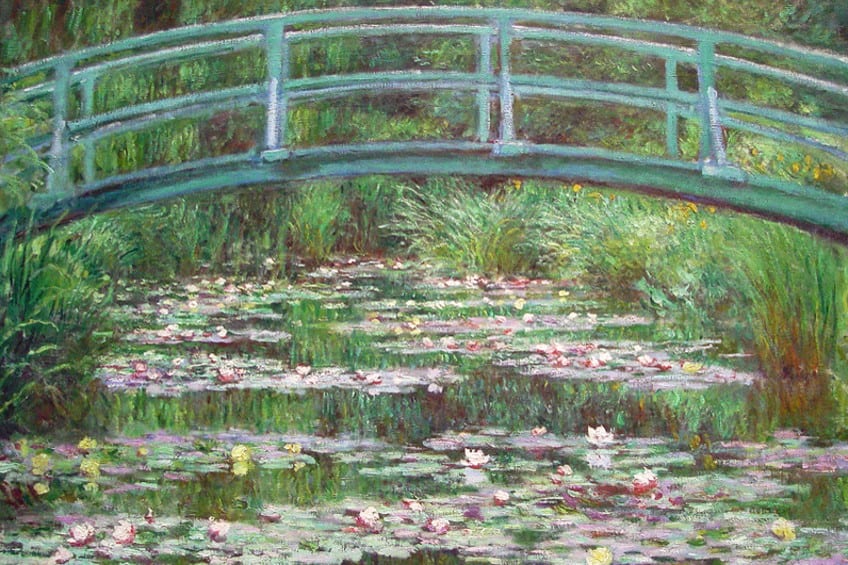“Japanese Bridge” by Claude Monet – The Famous Bridge Painting
Japanese Bridge or The Japanese Footbridge is a series of famous bridge paintings by Impressionist artist Claude Monet. These paintings had a significant influence on Modern Art history. Therefore, we will take a closer look at the artist behind these works, the career, and the socio-political context the works were created during, as well as complete a visual analysis of the artwork in this article.
Artist Abstract: Who Was Claude Monet?
Claude Monet (1840 – 1926) was a French painter who is seen as one of the founders of the Impressionist movement. Born in Paris in 1840, Monet was raised in Normandy, where he developed a love of nature and art at an early age. As a teenager, he studied art at the Le Havre Academy, where he learned the traditional techniques of drawing and painting. In the early 1860s, Monet moved to Paris and began to experiment with new styles and techniques, influenced by the works of the Realists and the Barbizon school.
In 1865, he met the artist Camille Pissarro, who would become a friend for the rest of his life and mentor. Together, they began to explore new approaches to painting that would eventually lead to the development of Impressionism.

Monet’s early works, such as The Haystacks in the Morning Sun (1891) and The Poppy Field (1873), reflect his interest in light and color, as well as his ability to capture the fleeting effects of nature. In the 1870s and 1880s, Monet’s style evolved, and he began to focus on the effects of light and atmosphere on the landscape, using loose brushstrokes and vibrant colors to create a sense of movement and immediacy. Throughout his career, Monet continued to push the boundaries of painting, experimenting with new techniques and subjects.
Some of his most famous works include the series of water lily paintings he created in his later years, such as Water Lilies (1917), which are considered masterpieces of the Impressionist movement.
Japanese Bridge by Claude Monet in Context
| Date | 1899 |
| Medium | Oil on canvas |
| Type of Painting | Landscape |
| Series | The Japanese Footbridge |
| Movement | Impressionism |
| Dimensions (cm) | 81.3 x 101.6 |
| Location | National Gallery of Art, Washington D.C., United States |
The Japanese Bridge is a painting series by the French impressionist Claude Monet, created in 1899. All 12 paintings depict a small wooden bridge in Monet’s garden at Giverny, France, from the same vantage point. Monet’s favorite water lilies and irises are in the foreground and a small Japanese-inspired pagoda is in the background. Let us look at the socio-political context as well as the context within Monet’s career that this series was created.
Socio-Political Context of the Japanese Bridge Paintings
At the time of this Japanese Bridge painting series creation, France was undergoing significant socio-political changes. The country had just emerged from the Franco-Prussian War and was in the midst of an industrial and cultural revolution. Monet and other impressionist artists were pushing the boundaries of traditional art and seeking to capture the rapidly changing world around them.
The Japanese Bridge paintings are a reflection of these changes and the increasing global interconnectedness of the time. The inclusion of the pagoda in the painting is a nod to the growing interest in Japanese culture in France.
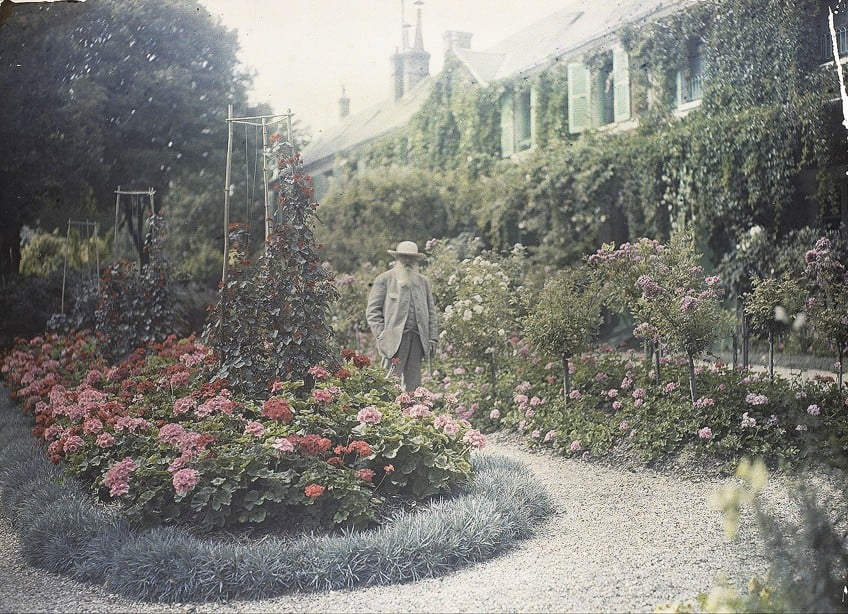
This interest was sparked by Japan’s victory over Russia in the Russo-Japanese War, which surprised and impressed many Europeans. The inclusion of water lilies and irises in the painting also reflects the increasing popularity of gardening and horticulture in France. Overall, The Japanese Bridge is a powerful example of the impressionist movement and its focus on capturing the beauty and fleeting nature of the world around us. It also reflects the changing socio-political climate of late 19th century France and Monet’s own personal experiences and interests.
Contextualizing Japanese Bridge Paintings in Monet’s Career
The famous bridge paintings by Claude Monet was created during a period of significant artistic growth for Monet. He had been a leading figure in the impressionist movement since its inception in the 1870s, but by the 1890s he was beginning to experiment with new techniques and subjects. The Japanese Bridge paintings reflect this experimentation, as Monet sought to capture the garden’s changing light and atmospheric conditions at different times of day and year.
The Japanese Bridge paintings are also a reflection of Monet’s personal interests and experiences. Monet was an avid gardener and spent many years perfecting the gardens at Giverny, where he lived and worked.
The inclusion of the bridge and the Japanese pagoda in the paintings reflects his interest in Japanese culture, which was growing in popularity in Europe at the time. The presence of the water lilies and irises in the paintings also reflects Monet’s love of gardening and his desire to capture the beauty of his own gardens.
Visual Analysis of Japanese Bridge by Claude Monet
In this section of the article, we will do a general visual analysis of the Japanese Bridge paintings by Claude Monet. Because most of these paintings were created from the same vantage point and with the same intention to study the effects of light there on, they show a lot of similarities when it comes to composition, color, texture, light use, perspective, and subject matter.
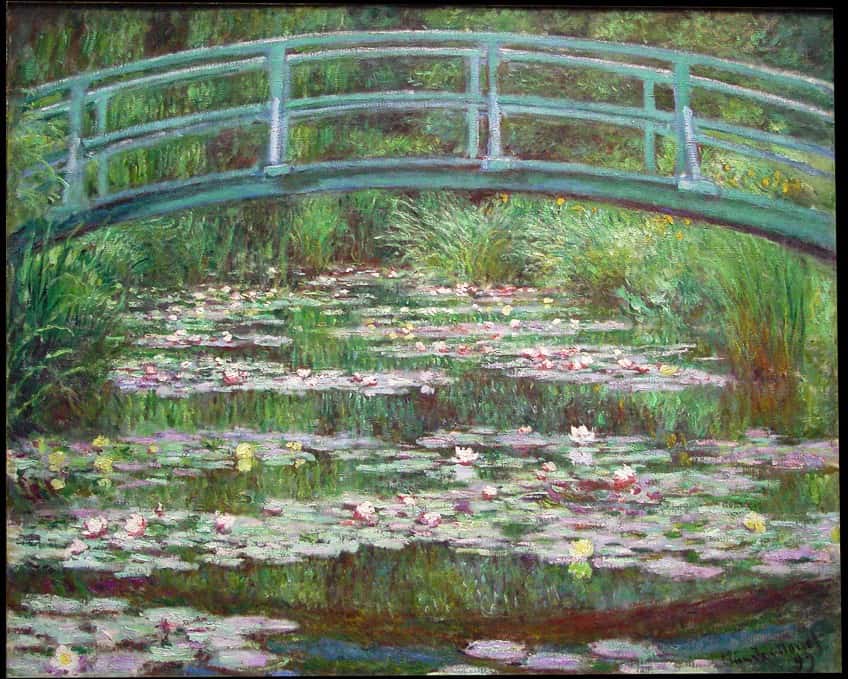
Composition
In Claude Monet’s painting The Japanese Bridge, the composition is dominated by the vertical lines of the bridge and pagoda, which act as a framing device for the horizontal bands of water and the lily pads in the foreground. The bridge and pagoda also draw the viewer’s eye toward the center of the painting, where the water lilies and irises create a sense of depth and perspective.
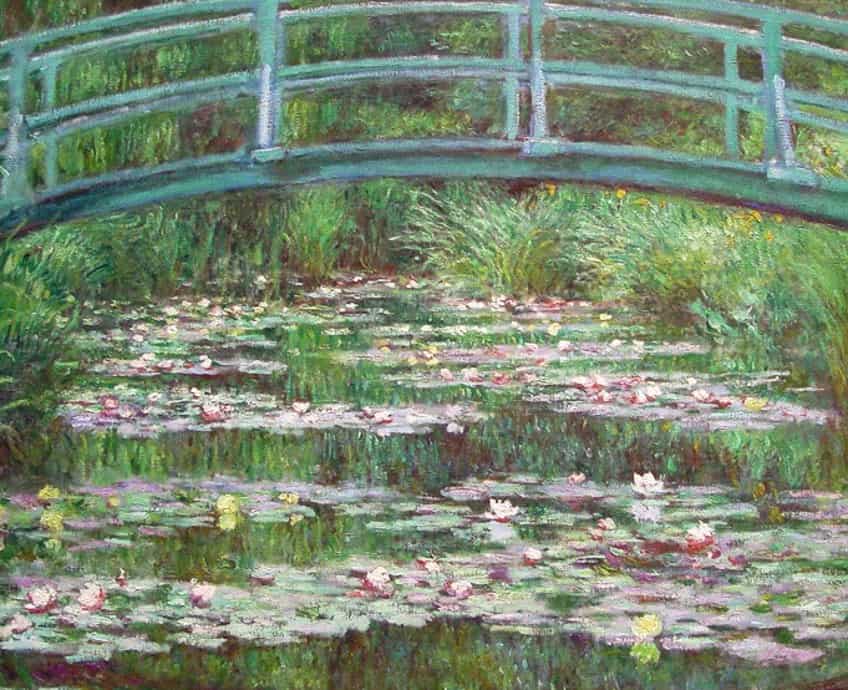
Subject Matter
The subject matter of the painting is the small wooden bridge and pagoda in Monet’s garden at Giverny, France. The inclusion of the pagoda reflects Monet’s interest in Japanese culture, which was growing in popularity in Europe at the time.
The presence of the water lilies and irises also reflects Monet’s love of gardening and his desire to capture the beauty of his own gardens.
Color and Light
In terms of color and light, the Japanese Bridge paintings are vibrant and atmospheric. The blue and green tones of the water and plants create a sense of tranquility, while the pink and white blossoms of the water lilies add a touch of brightness and beauty. The light in the painting is diffuse and soft, giving the scene a dream-like quality. The Japanese Bridge (1899) depicts the bridge in the morning, with a soft mist hanging over the water and the light filtering through the trees to create dappled shadows on the surface. The colors are softened and the brushwork was done in a loose style, giving the scene a dreamlike quality.
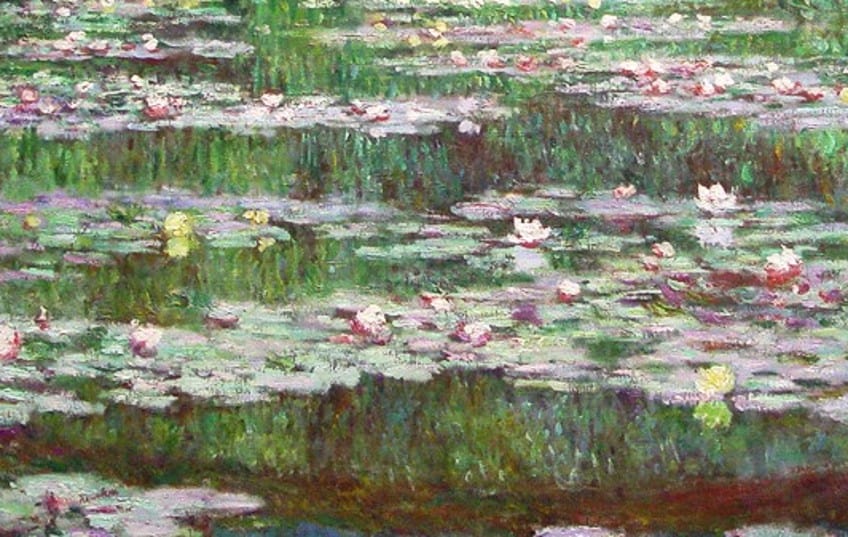
Water Lilies and Japanese Bridge (1899) was painted later in the day, and the light is brighter and more intense. The water is more active, with ripples and waves visible, and the colors are more vibrant. The brushstrokes are tighter and more defined, giving the scene a sense of motion and vitality. Japanese Bridge over Water Lilies (1900) is a more abstract interpretation of the scene, with the bridge and trees appearing as if they are made of brushstrokes rather than solid objects. The water is a blur of color and the light is filtered through the leaves of the trees, creating a sense of depth and movement.
Texture
The texture in the painting is created through Monet’s use of loose brushstrokes and impasto techniques. The brushstrokes give the painting a sense of movement and spontaneity, while the impasto adds a sense of depth and texture to the lily pads and flowers.
Perspective
The perspective in Japanese Bridge is slightly elevated, giving the viewer the sense of looking down at the scene from above. This perspective allows Monet to create a sense of depth and space, with the bridge and pagoda receding into the background and the lily pads and flowers appearing to rise up from the water.
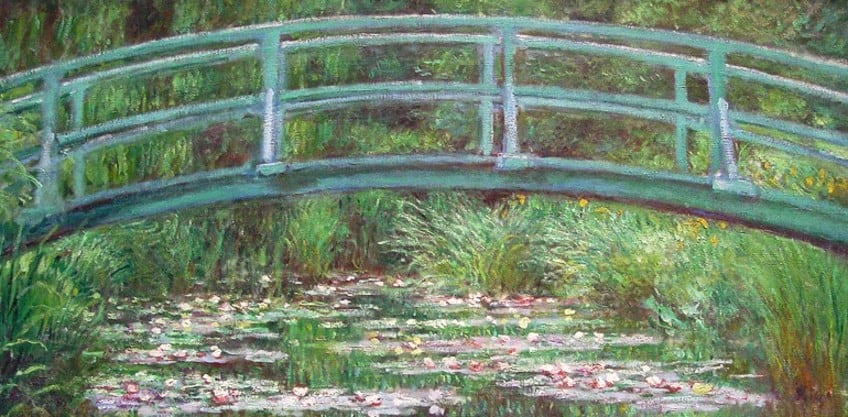
Symbolism
In terms of symbolism, the Japanese Bridge can be seen as a reflection of the changing times and Monet’s personal experiences. The inclusion of the pagoda reflects the growing interest in Japanese culture in Europe, while the presence of the water lilies and irises reflects Monet’s love of gardening.
The painting can also be seen as a celebration of the beauty and ephemeral qualities of the natural world.
The Legacy and Reception of the Japanese Bridge Paintings
The Japanese Bridge paintings were well-received by critics and the public alike. They were exhibited at the 1900 Paris Exposition Universelle, where they were praised for their beauty and technical skill. The paintings also helped to establish Monet’s reputation as a master of landscape painting and cemented his position as one of the leading figures of the impressionist movement.

Despite their success, the Japanese Bridge paintings were not without controversy. Some critics accused Monet of repeating himself and judged the series for being too identical to each other. However, Monet defended his decision to paint the same subject multiple times, arguing that he was trying to capture the ever-changing nature of light and atmosphere in the garden.
The Opinion of the Critics
One art critic who was particularly impressed by the paintings was Louis Vauxcelles (1870 – 1943). In a review for the French newspaper Gil Blas, Vauxcelles wrote: “Monet is a revolutionary…he has shown that it is possible to create a precious work of art without drawing or modeling, by the simple juxtaposition of colors.”
Another critic, Camille Mauclair (1872 – 1945), also praised the paintings in his review for the French newspaper La Revue Blanche. He wrote: “Monet’s paintings are a revelation. They show us the beauty of nature in all its fleeting, ephemeral glory.”
Overall, the Japanese Bridge paintings were received overwhelmingly positively. They were praised for their beauty and technical skill and helped to establish Monet’s reputation as a master of landscape painting. The paintings also helped to further the cause of the impressionist movement and inspire future generations of artists.
Why the Japanese Bridge Series Was So Revolutionary
The Japanese Bridge paintings are still famous today. This legacy is largely due to the impact the paintings had on other artists when they were created. Monet’s paintings of the Japanese bridge in his garden are considered revolutionary for a few reasons.
Depicting an Exotic Culture
First, it was one of the first Western paintings to depict a scene from Japan in a realistic manner. At the time it was created, Japan was a largely unknown and exotic country to most Europeans, and Monet’s painting offered a glimpse into its culture and beauty.

Impressionism as a Revolutionary Art Movement
Second, the paintings are notable for their use of color and composition. Monet was a master of the Impressionist style, which focused on catching the changing effects of light and color in a scene. In the Japanese Bridge paintings, he used a vibrant and varied palette to create a sense of light and movement, and he composed the painting in a way that drew the viewer’s eye to the bridge itself.
An Unusual Subject Matter
Finally, the Japanese bridge painting was revolutionary because of its subject matter. While many painters at the time were still focused on traditional subjects like historical scenes or religious iconography, Monet chose to paint a simple, everyday scene from Japan.
This choice was a departure from the norm and helped to pave the way for more modern, less traditional forms of art.
The Influence of the Japanese Bridge Paintings on Art History
Japanese Bridge by Claude Monet is a series of approximately 20 paintings created by the French impressionist artist between 1899 and 1922. These paintings have had a lasting impact on the course of art history and have influenced numerous artists and movements.
Compositional Choices
One of the most significant ways in which the Japanese Bridge paintings have influenced art history is through their unique approach to composition. The vertical lines of the bridge and pagoda act as a framing device for the horizontal bands of water and lily pads, creating a sense of balance and harmony in the composition.
Light and Atmosphere
The Japanese Bridge paintings have also had a lasting impact on the way in which artists approach the depiction of light and atmosphere in their work. Monet’s use of loose brushstrokes and impasto techniques helps to capture the changing light and atmospheric conditions of the garden at different times of day and year.
This approach to light and atmosphere has been influential for many subsequent artists, including the American impressionist Childe Hassam (1859 – 1935).
Impressionism
Another way in which the Japanese Bridge paintings have influenced art history is through their role in the development of the impressionist movement. Before Impressionism, artists were stuck in having to portray subject matters that were socially, politically, religiously, or historically relevant.
Comparing Monet’s Water Lilies Paintings with His Japanese Bridge Paintings
Claude Monet was a pioneering French Impressionist painter known for his beautiful and evocative works depicting the natural world. Two of his most famous series of paintings are his Water Lilies and Japanese Bridge works. While both series showcase Monet’s skill and vision, they also demonstrate some significant differences in terms of composition, color, and mood. One of the most obvious distinctions between the two series is the use of color. Monet’s Water Lilies paintings are characterized by a soft, muted color palette, with gentle pinks, greens, and blues dominating the canvases.
In contrast, his Japanese Bridge paintings are much more vibrant and varied, with bold reds, oranges, and yellows adding a sense of warmth and movement to the scenes.
Another difference can be seen in the compositions of the paintings. Monet’s Water Lilies paintings often feature a central focal point, such as a single water lily or a small cluster of flowers, surrounded by a vast expanse of water and sky. This creates a sense of calm and tranquility, with the viewer’s eye drawn to the serene beauty of the natural world. In contrast, Monet’s Japanese Bridge paintings are more crowded and complex, with a network of paths, trees, and buildings all vying for the viewer’s attention. This creates a sense of liveliness and activity and adds a little enigma and intrigue to the scenes.
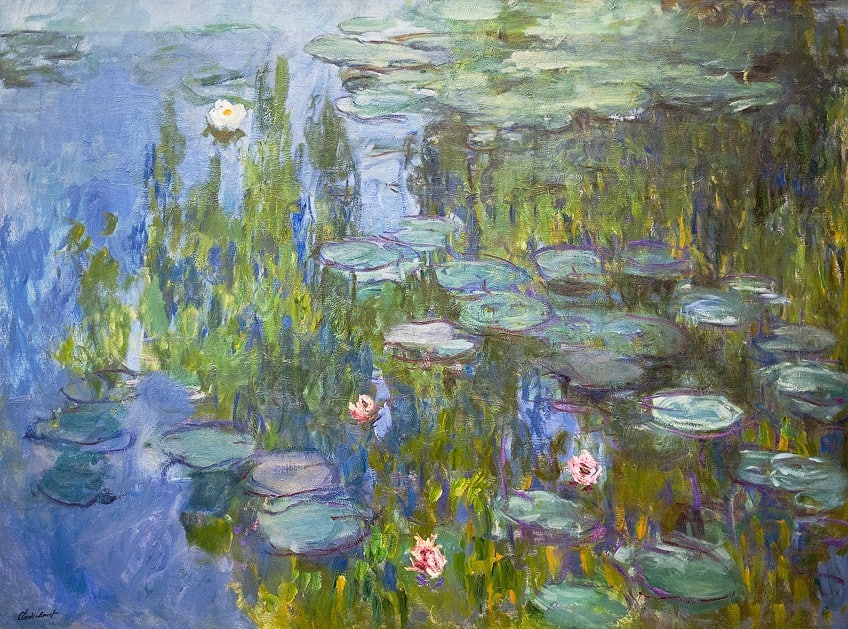
Despite these differences, both series of paintings are undeniably beautiful and deeply evocative. Monet’s Water Lilies paintings capture the quiet magnificence of the natural world, while his Japanese Bridge paintings offer a glimpse into a mysterious and exotic culture. Together, they demonstrate Monet’s extraordinary talent as a painter and his unique ability to capture the fleeting effects of light and color in his works.
Overall, the Japanese Bridge paintings are an important part of Monet’s career and the history of the Impressionist movement. They showcase his technical skill and his ability to capture the beauty of the natural world. They also reflect his personal interests and the changing socio-political climate of late 19th and early 20th century France. These paintings are iconic of the Impressionist style, and also added to a lineage of artists that followed Monet in exploring similar themes and techniques.
Frequently Asked Questions
Why Is Claude Monet Considered So Influential?
In addition to his own art, Claude Monet (1840 – 1926) had a profound impact on the development of Impressionism, inspiring and influencing many other artists, including Pierre-Auguste Renoir, Edgar Degas, and, Alfred Sisley. Today, his work is celebrated as an important part of art history and his paintings continue to be held in high esteem, with his art being studied by art lovers all around the world.
How Many Japanese Bridge Paintings Did Claude Monet Create?
Claude Monet (1840 – 1926) created approximately 20 paintings of the Japanese footbridge in his beloved garden at Giverny. However, because the artist was known to create multiple iterations of the same landscape in an attempt to capture the changing light and seasons, the exact number of paintings in the Japanese Bridge series is unknown.
What Do the Famous Bridge Paintings by Monet Represent?
Although this painting series can be said to represent the socio-political changes in France at the time, it is also a reflection of Monet’s personal interests and experiences. Monet was an avid gardener and had spent many years perfecting the gardens at Giverny, where he lived and worked. The Japanese Bridge paintings are a celebration of this labor of love and a testament to Monet’s skills as a landscape artist.
Nicolene Burger, a South African multimedia artist and creative consultant, specializes in oil painting and performance art. She earned her BA in Visual Arts from Stellenbosch University in 2017. Nicolene’s artistic journey includes exhibitions in South Korea, participation in the 2019 ICA Live Art Workshop, and solo exhibitions. She is currently pursuing a practice-based master’s degree in theater and performance. Nicolene focuses on fostering sustainable creative practices and offers coaching sessions for fellow artists, emphasizing the profound communicative power of art for healing and connection. Nicolene writes blog posts on art history for artfilemagazine with a focus on famous artists and contemporary art.
Learn more about Nicolene Burger and about us.
Cite this Article
Nicolene, Burger, ““Japanese Bridge” by Claude Monet – The Famous Bridge Painting.” artfilemagazine – Your Online Art Source. March 13, 2023. URL: https://artfilemagazine.com/japanese-bridge-by-claude-monet/
Burger, N. (2023, 13 March). “Japanese Bridge” by Claude Monet – The Famous Bridge Painting. artfilemagazine – Your Online Art Source. https://artfilemagazine.com/japanese-bridge-by-claude-monet/
Burger, Nicolene. ““Japanese Bridge” by Claude Monet – The Famous Bridge Painting.” artfilemagazine – Your Online Art Source, March 13, 2023. https://artfilemagazine.com/japanese-bridge-by-claude-monet/.


